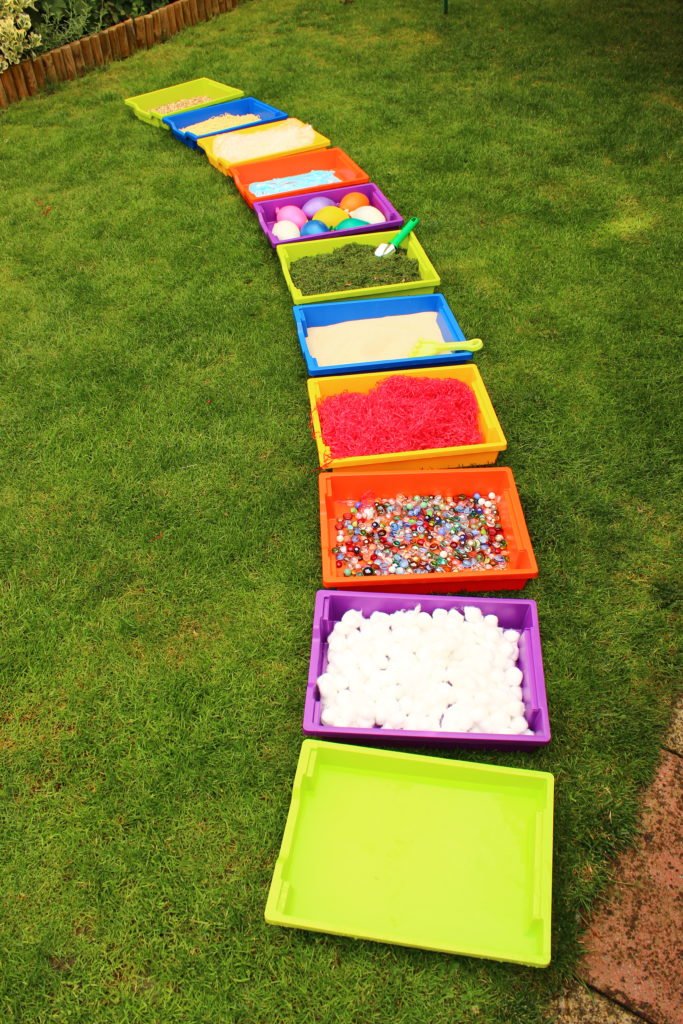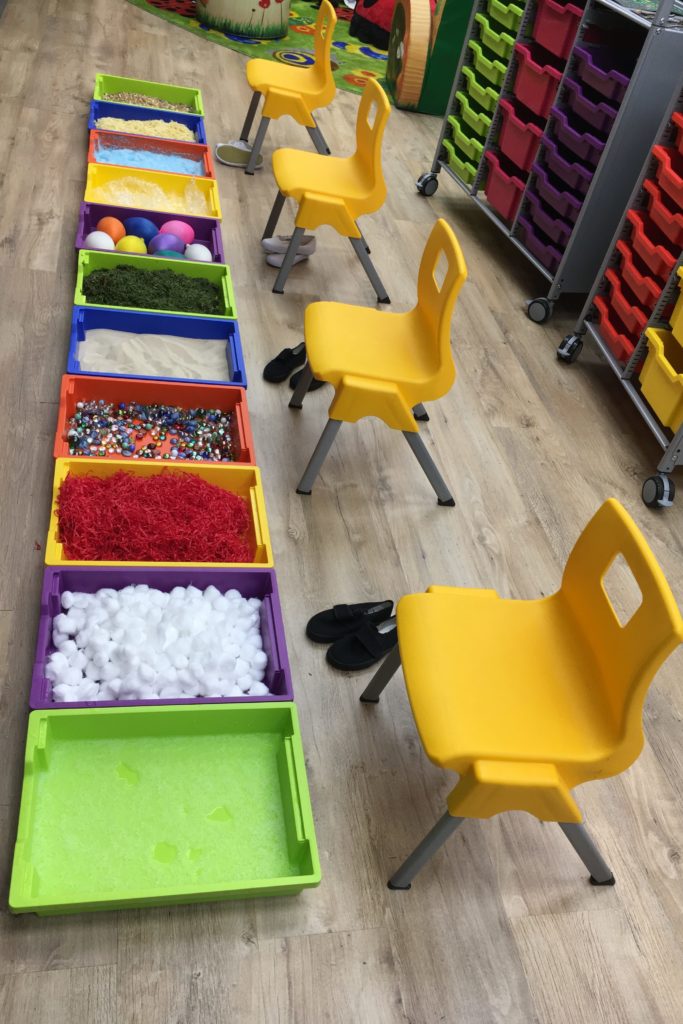Sensory trays
Use your senses to explore the different textures and materials found in a diverse collection of sensory trays. Working outdoors or inside, set up a sensory walk, seated stations or table-top feely trays.


Learning outcomes
You will be able to:
- Use your sense of touch to explore and identify a range of different materials.
- Describe the properties of a range of different materials.
You will need (per class):
- A flat area of ground or tabletop space for the trays to be placed on
- 6-10 x Shallow (F1) or A3 Paper (D3) Gratnells trays
- A range of different materials (reused/recycled where possible) sufficient to up to half-fill a shallow tray, for example:
- Bird seed
- Cooked and chilled spaghetti or pasta shells
- Shaving foam
- Bubble wrap
- Small water filled balloons
- Grass cuttings
- Sand
- Plastic beads
- Smooth pebbles
- Packing foam
- Packing beads
- Shredded paper
- Cotton wool balls
- Water
- Water beads
- Jelly
- Soapy water
- 6-10 x Small chairs
- Black cloths or large pieces of newspaper to cover the trays (~50cm x 50cm in size) (optional)
- 6-10 x Blindfolds (optional)
- Mini whiteboards, notebooks, post-it notes, voice recorder or video recorder for recording adjectives.
- Camera (optional).
- Cloths or towels for drying or cleaning hands or feed
This activity also works for individuals or small teams and can be repeated multiple times.
Preparation:
- Up to half fill each tray with a different material per tray. Select materials appropriate to the age of the participants.
- Set the trays out as either;
- a sensory walk, outdoors or indoors. You may wish to leave a space between each tray or have the participants step from one tray directly in to the next. Use a chair back, placed adjacent to each tray, as a support for those who need something to hold on to while stepping into and out of each tray.
- a sensory sit-down activity. With each tray placed in front of a chair for the participants to put their feet into. You may wish to cover each tray with an opaque cloth and have a blindfold available for each participant.
- a tabletop sensory activity for participants to explore with their hands. You may wish to cover each tray with an opaque cloth and have a blindfold available for each participant.
What to do:
- Each participant should explore each tray in turn, using either bare feet or their hands depending on the set up you have chosen.
- Each participant should articulate what they feel and, if blindfolded, say what they think the item is. Use as many describing words (adjectives) as possible.
- Record the adjectives using your chosen method.
- Move to the next tray.
- All participants can simultaneously carousel around all trays. If carrying out a tabletop activity, more than one participant could have their hands in each tray at a time.
- Share and reflect on the different feelings and adjectives captured for each tray.
What is happening?
Humans have five basic senses, sight, hearing, small, taste and touch. The sense organs associated with each sense send information to our brains to help us understand and perceive the world around us, for example, our skin and its neurons (nerve cells) are responsible for our sense of touch and our nose (or more specifically the nerve endings in the olfactory cleft found on the roof of the nasal cavity) is responsible for our sense of smell. This activity requires you to use your sense of touch to explore a wide variety of materials, you can try this with and without a blindfold to see if you are better able to sense and describe items with your eyes closed.
Some people suffer from sensory impairment, or a reduced sense of touch, this can be due to peripheral nerve damage or reduced function of the peripheral nerves. Try doing this activity with non-latex gloves on and compare how the objects feel, this will help to simulate what a person with this type of sensory impairment may feel.
Other things to try…
- As a group, rank or sort the tray contents by different criteria or properties, e.g. hardest to softest, driest to wettest/slimiest, warmest to coldest. Can you come up with your own sorting criteria? Discuss why you feel each should be put into its position in the ranking, move the trays into an order you all agree on.
- Swap the contents of the trays for alternative items.
- Create a themed sensory tray activity for Easter or Christmas, or make one for each season with each tray containing a different found natural object.
- Set the participants a challenge to place a mystery item into a tray and challenge their friends to identify what it is (while wearing a blindfold). Restrict to natural or man-made objects to tailor the challenge.
- Introduce the use of additional senses, such as smell or taste, being sure to select appropriate items for each tray.
- Have a discussion around sensory impairment. What difference does the blindfolded make? What other sensory impairments are there? Some people have a reduced sense of touch and it can be difficult for them to feel things with their fingers or toes. Repeat the tabletop activity but this time wearing non-latex gloves, this will help to simulate what a person with this type of sensory impairment may feel.
- Share your sensory tray photographs, videos and captured adjectives on social media using #WhatsInMyTray.
Health & Safety
As with all Gratnells Learning Rooms What’s In My Tray activities, you should carry out your own risk assessment prior to undertaking any of the activities or demonstrations.

